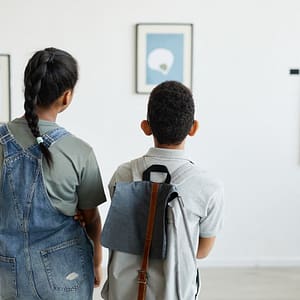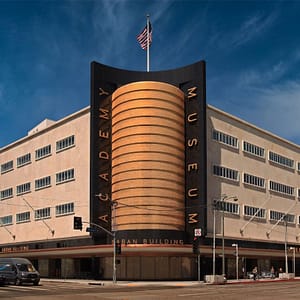Best Practices for Bilingual Exhibition Design
Linguistic diversity in the U.S. is growing. Museums and other cultural institutions are adapting to the changing needs of their communities by translating exhibit didactics and other visitor materials. Creating bilingual exhibitions that are both accessible and engaging helps visitors from different linguistic backgrounds understand and engage with the content on display. In this article, we will explore some tips and best practices for designing bilingual exhibition materials that are inclusive and inviting to a broad range of visitors. While this article specifically examines bilingual exhibits, the tactics are equally applicable to exhibits with more than two languages.
Parity Between Languages
Ensuring equal treatment of both languages is fundamental to bilingual exhibition design. This means that both the source and target language must be equally well represented in the visual hierarchy.
This principle is applied through the selection of font sizes, colors, and graphics. While it may be tempting to use different font sizes, this tactic can visually prioritize one language over another. Different colors are sometimes used to distinguish between languages, however it’s important to exercise care with this approach. Ensure that the chosen colors are equally legible and result in proper readability and aesthetics for both languages. Too many colors might appear juvenile for scientific or cultural content. Color selections must also be appropriate for people with color vision deficiencies.
Maintain Consistency in the Presentation of Languages
Many institutions will elect to place the source text and translation side-by-side, or stack one language above the other. If taking this approach, be consistent in the way the languages are presented. When translations are placed consistently throughout an exhibit, visitors can quickly identify their preferred language. For hand-held supplementary materials such as gallery cards, brochures, and family guides, a common solution is to place one language on one side and the translation on the other. Again, be consistent in the placement of translations if creating a series of such collateral.
Per the Bilingual Exhibit Research Initiative’s detailed study of Spanish-speaking visitors, the large majority of groups use both languages during their visit, commonly switching between them, sometimes even within the same sentence. This “code switching” comes effortlessly and naturally, often when people encounter a word or phrase that is more easily understood in one language than in another. This unexpected finding highlights the value of having both languages available simultaneously, with consistent placement, and treated with equal visual hierarchy.
Flexible Design Solutions
Designing for multiple languages may require creative solutions to accommodate the increased text volume. Adding a translation next to the source language doubles the amount of text a visitor sees. The text volume is further increased with languages like Spanish that utilize 25% more characters than English. Plan accordingly to avoid text-heavy, unapproachable blocks of text. Certain types of exhibits may work well with large graphics and images to complement the text, making the information more engaging and accessible. This approach is particularly helpful for children and visitors who may have difficulty reading.
Get in Touch!
Reach out to discuss your next translation project with a member of our team.
Present the Full Picture in Translation
When presenting a bilingual exhibit, it is most equitable to translate all relevant material. This approach enables all visitors to fully experience the exhibition as intended and not miss part of the story being told. Sometimes, however, budgetary constraints do not permit fully bilingual didactics. A museum may elect to only present certain translated exhibit components such as titles and headers on the walls and make the complete exhibition didactics available in hard copy in the galleries, in an app, or on the institution website.
Be Sensitive to Cultural Nuances
Some concepts, such as humor, idioms, or cultural references, may not translate well. It’s crucial to adapt titles, headers, and text to avoid potential miscommunication or misunderstanding. Design elements and images should also be culturally appropriate to the target audience to create a cohesive and inclusive experience.
Audio and Multimedia Considerations
Our tips for language parity, visual clues, and cultural appropriateness aren’t limited to printed text. In-gallery video, interactive media, and listening stations should also be translated in a manner that is clear and accessible to all visitors. Voiceover narration not only supports linguistic accessibility, it also provides options for individuals with visual impairments or reading difficulties.
- When using bilingual narration, clearly identify the available languages and ensure the narrator has the appropriate dialect for the target audience.
- Be mindful of text expansion in audio and video, as different languages may require more time to convey the same message through narration or subtitling.
Featured Services
Learn more about…
Visual Clues for Identifying Preferred Languages
To make it easy for visitors to identify their preferred language on interactive media or print collateral, use visual clues. When identifying a language by name, make sure it is written in that language, for example Français instead of “French.” While it may be tempting to label languages using flags, this is generally not advisable, as many languages cross national borders. There is often not a one-to-one correlation between a country and the regions where a language is spoken.
Early Planning and Collaboration
For best results, do not make translation an afterthought. Design your exhibit with translation in mind from the start and collaborate with a reliable language service provider early on. And of course, successful execution is only part of the story. Promote your exhibit as bilingual to raise awareness and attract visitors who speak the additional language.
By following these best practices, museums and other cultural institutions can create multilingual exhibitions that are accessible, inclusive, and engaging for a diverse audience. It’s essential to maintain parity between languages and apply effective design strategies to ensure that visitors from different backgrounds can fully appreciate the museum’s offerings. A well-executed multilingual exhibition not only reflects the institution’s commitment to diversity but enriches the visitor experience.
 Named to the 2024 Inc. 5000 list of fastest-growing companies and ranked among the world’s top 100 language service providers by CSA Research
Named to the 2024 Inc. 5000 list of fastest-growing companies and ranked among the world’s top 100 language service providers by CSA Research

